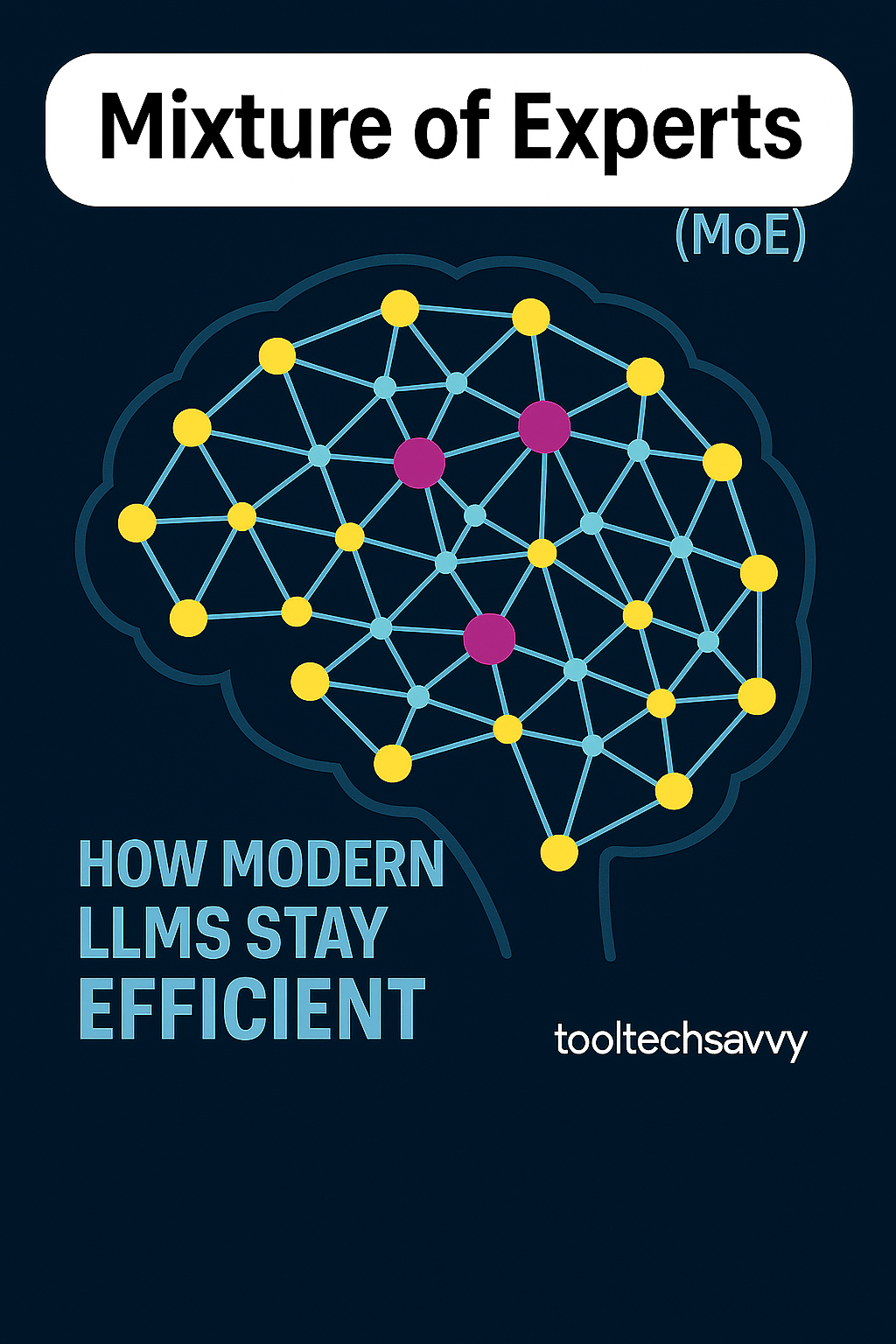The latest generation of AI models — from GPT-4 to Gemini — are getting bigger, smarter, and surprisingly more efficient. But how can systems with hundreds of billions of parameters run faster than smaller models from just a year ago?
The answer lies in a powerful architecture called Mixture of Experts (MoE) — a design that allows large language models (LLMs) to use only the parts of their “brain” they need for each task.
Let’s break down how it works, why it’s revolutionary, and how it’s shaping the next phase of AI efficiency.
What Is Mixture of Experts (MoE)?
Traditional AI models use dense architectures, meaning every layer and neuron participates in generating a response. While effective, it’s computationally expensive — especially at scale.
MoE flips that idea. Instead of activating all the model’s neurons, it activates only a subset of specialized “experts” depending on the input.
Imagine having a room full of specialists — writers, coders, analysts — and calling on just two or three based on the question you ask. That’s MoE in action.
Each expert is a small neural network trained to handle specific types of data or reasoning. A router decides which experts should activate for each prompt, optimizing both performance and speed.
For a simpler foundation on AI architecture, read Get Better AI Results: Master the Basics of AI Architecture.
How MoE Works (Step by Step)
- Input arrives: You type your prompt or query.
- Router activates: The model’s router decides which experts are best suited for your input.
- Selective activation: Only a few experts (say 2 out of 64) process the data.
- Aggregation: The outputs from those experts are combined into a final response.
This means most of the model remains idle during a single task — saving both time and energy.
💡 In short: MoE makes LLMs “sparsely activated” — powerful but efficient.
If you’d like a visual overview of model processing, check out What Happens When You Hit ‘Send’? The Journey of an AI Request.
Why Big Tech Loves MoE
Companies like OpenAI, Anthropic, and Google DeepMind are leaning heavily into MoE architectures because they allow scaling without exploding costs.
Here’s why it matters:
- Efficiency: Only a few experts activate per request — less GPU time, less energy.
- Speed: Faster inference since fewer parameters are processed.
- Specialization: Different experts handle different topics — improving quality.
- Scalability: You can grow the model (add more experts) without linearly increasing computation costs.
For context, Google’s Switch Transformer was one of the first large-scale MoE models — activating just 1% of its parameters at any given time. That innovation paved the way for today’s massive-yet-manageable AI systems.
Dive deeper into efficiency optimization in Scaling AI Efficiently: The Ultimate Guide to Production Cost Savings.
MoE vs Dense Models: The Real Difference
| Feature | Dense Model | Mixture of Experts (MoE) |
|---|---|---|
| Activation | All neurons active | Select few experts active |
| Speed | Slower | Faster per query |
| Cost | High | Lower |
| Specialization | Generalized | Task-specific |
| Scalability | Limited | Highly scalable |
While dense models are still great for smaller tasks, MoE architectures shine when scaling models beyond 100B parameters — allowing them to grow smarter without getting slower.
To understand how such architectures evolve, read What OpenAI’s Latest GPT Update Means for Everyday Users.
The Hidden Efficiency Trick: Expert Routing
The router is the unsung hero of the Mixture of Experts approach.
It’s responsible for selecting which experts to activate. The router uses probabilities to decide which subnetworks are most relevant — often choosing the top 2–4 experts per token.
This selective mechanism reduces redundancy while maintaining output quality.
If you’re curious how token processing plays into this, revisit Token Limits Demystified: How to Fit More Data Into Your LLM Prompts.
Trade-offs and Challenges
MoE is powerful, but it isn’t perfect. Its challenges include:
- Load balancing: Some experts get overused, while others remain undertrained.
- Router complexity: Poor routing can degrade accuracy.
- Distributed training: Running hundreds of experts efficiently requires advanced hardware orchestration.
Still, the industry consensus is clear: MoE is the most promising path to sustainable large-scale AI.
If you’re exploring cost-efficient AI development, you’ll find Optimizing AI Workflows: Batching, Caching, and Rate Limiting incredibly useful.
Real-World Examples
Several cutting-edge models now use MoE architecture:
Mixtral 8x7B: This open-source model from Mistral AI uses 8 experts with 2 activated per token, achieving performance comparable to much larger dense models while being far more efficient.
GPT-4: While OpenAI hasn’t confirmed the architecture publicly, industry analysis suggests GPT-4 likely employs MoE techniques with multiple expert models specialized for different capabilities, contributing to its versatile performance across diverse tasks.
Google’s Switch Transformer: One of the first large-scale MoE models, demonstrating how the approach scales to trillion-parameter systems.
The Future of MoE and Efficient AI
In the next generation of AI, Mixture of Experts will play a central role in:
- Personalized expert activation per user.
- Dynamic routing based on task history.
- Cross-model collaboration (multi-agent systems).
Combined with agentic AI design — where models act autonomously — MoE will make future AIs not only faster but also smarter in choosing how they think.
For a glimpse into this evolution, check out How to Adopt the Agentic AI Mindset in 2025.
Final Thoughts
Mixture of Experts isn’t just a technical optimization — it’s a philosophical shift. It moves AI away from brute-force intelligence toward collaborative intelligence — where multiple smaller minds work together to produce one elegant answer.
By activating only the “experts” you need, MoE gives AI a new kind of efficiency — one inspired by how humans collaborate and specialize.
Want to level up your understanding of modern AI architectures? Don’t miss The Future Is Hybrid: Everything You Need to Know About Multi-Modal AI.
Related Reads:



